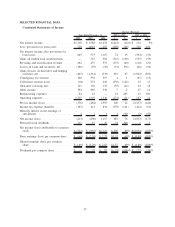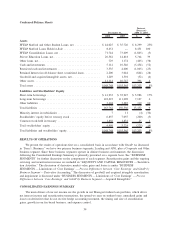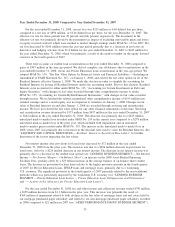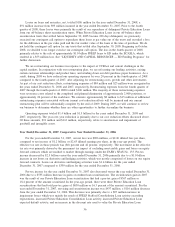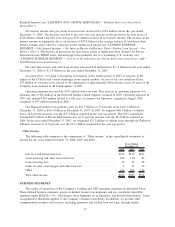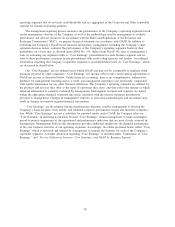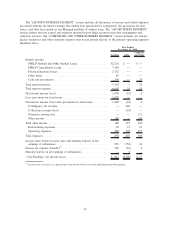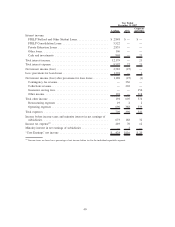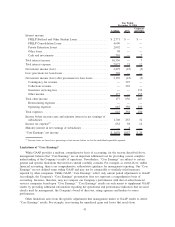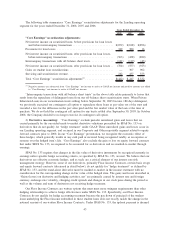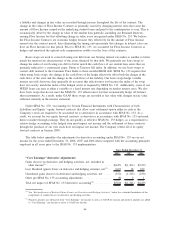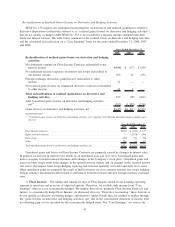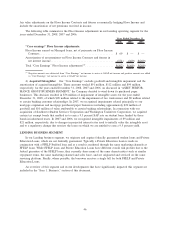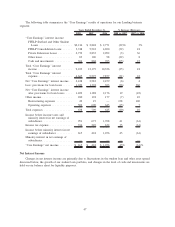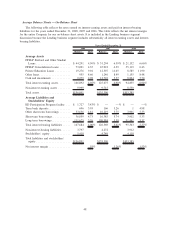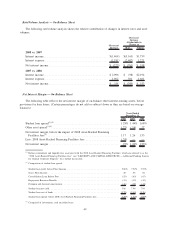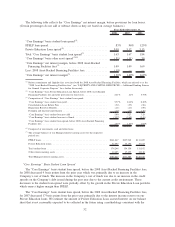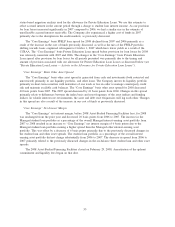Sallie Mae 2008 Annual Report Download - page 44
Download and view the complete annual report
Please find page 44 of the 2008 Sallie Mae annual report below. You can navigate through the pages in the report by either clicking on the pages listed below, or by using the keyword search tool below to find specific information within the annual report.
The following table summarizes “Core Earnings” securitization adjustments for the Lending operating
segment for the years ended December 31, 2008, 2007 and 2006.
2008 2007 2006
Years Ended December 31,
“Core Earnings” securitization adjustments:
Net interest income on securitized loans, before provisions for loan losses
and before intercompany transactions .......................... $(872) $(818) $(896)
Provisions for loan losses..................................... 309 380 16
Net interest income on securitized loans, after provisions for loan losses,
before intercompany transactions ............................. (563) (438) (880)
Intercompany transactions with off-balance sheet trusts ............... (141) (119) (43)
Net interest income on securitized loans, after provisions for loan losses . . (704) (557) (923)
Gains on student loan securitizations ............................ — 367 902
Servicing and securitization revenue ............................. 262 437 553
Total “Core Earnings” securitization adjustments
(1)
.................. $(442) $ 247 $ 532
(1)
Negative amounts are subtracted from “Core Earnings” net income to arrive at GAAP net income and positive amounts are added
to “Core Earnings” net income to arrive at GAAP net income.
“Intercompany transactions with off-balance sheet trusts” in the above table relate primarily to losses that
result from the repurchase of delinquent loans from our off-balance sheet securitization trusts. When Private
Education Loans in our securitization trusts settling before September 30, 2005 became 180 days delinquent,
we previously exercised our contingent call option to repurchase these loans at par value out of the trust and
recorded a loss for the difference in the par value paid and the fair market value of the loan at the time of
purchase. We do not hold the contingent call option for any trusts settled after September 30, 2005. In October
2008, the Company decided to no longer exercise its contingent call option.
2) Derivative Accounting: “Core Earnings” exclude periodic unrealized gains and losses that are
caused primarily by the one-sided mark-to-market derivative valuations prescribed by SFAS No. 133 on
derivatives that do not qualify for “hedge treatment” under GAAP. These unrealized gains and losses occur in
our Lending operating segment, and occurred in our Corporate and Other reportable segment related to equity
forward contracts prior to 2008. In our “Core Earnings” presentation, we recognize the economic effect of
these hedges, which generally results in any cash paid or received being recognized ratably as an expense or
revenue over the hedged item’s life. “Core Earnings” also exclude the gain or loss on equity forward contracts
that under SFAS No. 133, are required to be accounted for as derivatives and are marked-to-market through
earnings.
SFAS No. 133 requires that changes in the fair value of derivative instruments be recognized currently in
earnings unless specific hedge accounting criteria, as specified by SFAS No. 133, are met. We believe that our
derivatives are effective economic hedges, and as such, are a critical element of our interest rate risk
management strategy. However, some of our derivatives, primarily Floor Income Contracts, certain basis swaps
and equity forward contracts (discussed in detail below), do not qualify for “hedge treatment” as defined by
SFAS No. 133, and the stand-alone derivative must be marked-to-market in the income statement with no
consideration for the corresponding change in fair value of the hedged item. The gains and losses described in
“Gains (losses) on derivative and hedging activities, net” are primarily caused by interest rate and foreign
currency exchange rate volatility, changing credit spreads and changes in our stock price during the period as
well as the volume and term of derivatives not receiving hedge treatment.
Our Floor Income Contracts are written options that must meet more stringent requirements than other
hedging relationships to achieve hedge effectiveness under SFAS No. 133. Specifically, our Floor Income
Contracts do not qualify for hedge accounting treatment because the pay down of principal of the student
loans underlying the Floor Income embedded in those student loans does not exactly match the change in the
notional amount of our written Floor Income Contracts. Under SFAS No. 133, the upfront payment is deemed
43


